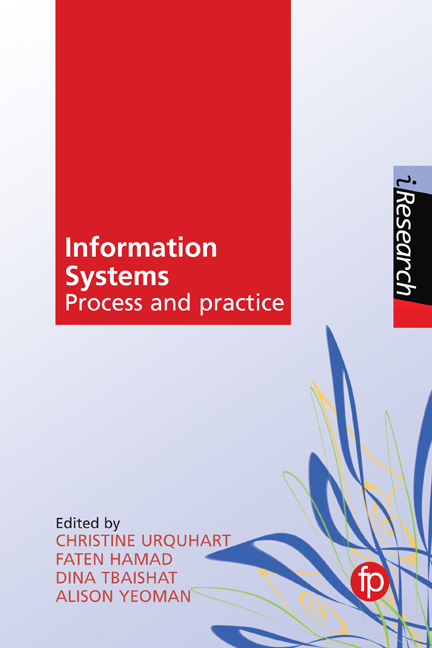Book contents
- Frontmatter
- Contents
- List of tables and figures
- Series editor's foreword
- About the authors
- 1 Introduction
- 2 Approaches to information architecture
- 3 Taxonomy testing for information architecture
- 4 The enterprise website and its information structures
- 5 Analysing activities, roles and processes
- 6 Libraries and the organisation of library processes – a history of operational research, and the use of process modelling
- 7 Using Riva process modelling to study book acquisition in academic libraries
- 8 Workflow analysis and process mapping in US academic libraries
- 9 A theoretical framework for designing and evaluating semi-structured document triage interfaces
- 10 Resource discovery case studies
- 11 Increasing social connection through a community-of-practice-inspired design
- 12 Methods for studying information provision, networking and communication in patient support groups
- 13 Health information systems: clinical data capture and document architecture
- 14 Producing systematic reviews and getting evidence to the clinician
- Index
11 - Increasing social connection through a community-of-practice-inspired design
Published online by Cambridge University Press: 08 June 2018
- Frontmatter
- Contents
- List of tables and figures
- Series editor's foreword
- About the authors
- 1 Introduction
- 2 Approaches to information architecture
- 3 Taxonomy testing for information architecture
- 4 The enterprise website and its information structures
- 5 Analysing activities, roles and processes
- 6 Libraries and the organisation of library processes – a history of operational research, and the use of process modelling
- 7 Using Riva process modelling to study book acquisition in academic libraries
- 8 Workflow analysis and process mapping in US academic libraries
- 9 A theoretical framework for designing and evaluating semi-structured document triage interfaces
- 10 Resource discovery case studies
- 11 Increasing social connection through a community-of-practice-inspired design
- 12 Methods for studying information provision, networking and communication in patient support groups
- 13 Health information systems: clinical data capture and document architecture
- 14 Producing systematic reviews and getting evidence to the clinician
- Index
Summary
COMMENTARY: CHRISTINE URQUHART
Catherine Burns and Adam Euerby used cognitive work analysis to help design a website intended to foster community of practice principles in order to improve networking. First, we need to appreciate the history of cognitive work analysis, and where the ideas about the work domain analysis come from. It's important to recognise that both cognitive work analysis and communities of practice have evidence behind their concepts, and that they are not merely theoretical frameworks that seem to work.
Cognitive work analysis comes from studies conducted by Rasmussen and colleagues at the Riso National Laboratory in Denmark in the early 2000s (Naikar, 2017). They were tasked with improving the safety of nuclear power plants in Denmark. Observations confirmed that the hardware was indeed reliable, but that, despite this, accidents could still happen. Human error appeared responsible, when workers were confronted with unfamiliar circumstances. However, the research indicated that had the workers known fully the state of the system, they could have formulated an appropriate response. Later research examined six professional technicians, problem-solving with different types of instruments, which each had a particular fault. Detailed analysis of the verbal protocols (think-aloud protocols) produced a coding scheme that revealed patterns in the reasoning used by the technicians. The technicians reasoned at different levels of abstraction (from the physical properties to the general functional purpose) and at different levels of decomposition (whole system through to a component). This formed what they termed the two-dimensional abstraction-decomposition space. Generally, the technicians started in the most abstract (purpose)/whole system corner and worked through to the opposite corner (physical form/component) – although the line of working could zig zag a little. These findings led to the first stage of cognitive work analysis modelling – the work domain analysis. This was developed by Vicente (2002) (among others) for design of interfaces that displayed three modes of cognitive reasoning: skill-based, rules-based and knowledge-based behaviour. The aim of systems designed through CWA is often to support workers in dealing with unexpected situations. Workers should be able to explore a number of ways of dealing with the situation while remaining within the boundaries of acceptable performance (Naikar, 2017).
- Type
- Chapter
- Information
- Information SystemsProcess and Practice, pp. 185 - 204Publisher: FacetPrint publication year: 2017



